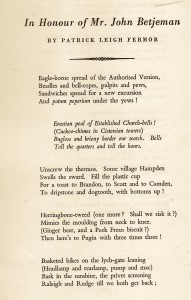 Even today, thirty six years after his death, John Betjeman can still surprise us with his wisdom and original mind. In 1947, less than two years after the end of a war that brought the prospect of a radiation death to the innocent citizens of Great Britain, destroyed some of finest Georgian terraces in London and Bath, that peppered landmark buildings, including St Paul’s Cathedral and the Dulwich Art Gallery with shrapnel, and pock-marked the pastoral landscapes of Surrey, Middlesex and Essex, the editors at Methuen asked the rising poet of the suburbs to provide an Introduction to their new anthology by someone called J. D. Mortimer ( who he?) on the Home Counties.
Even today, thirty six years after his death, John Betjeman can still surprise us with his wisdom and original mind. In 1947, less than two years after the end of a war that brought the prospect of a radiation death to the innocent citizens of Great Britain, destroyed some of finest Georgian terraces in London and Bath, that peppered landmark buildings, including St Paul’s Cathedral and the Dulwich Art Gallery with shrapnel, and pock-marked the pastoral landscapes of Surrey, Middlesex and Essex, the editors at Methuen asked the rising poet of the suburbs to provide an Introduction to their new anthology by someone called J. D. Mortimer ( who he?) on the Home Counties.
Betjeman duly obliged and what he wrote is redolent of his unique perspective on southern England. A writer of an earlier generation—a Walter-de-la Mare, a Blunden, a S. P. B.Mais say—would have come up with the usual nostalgic picture of the Home Counties as places of elm-shaded inns, haystacks, cricket on the green and dusty lanes, and left it at that, but Betjeman while regretting that much of Middlesex and parts of Surrey were now unrecognisable from their nineteenth and early twentieth century appearance, thanks to the depredations of the car, , and the presence in the sky of the aeroplane, suggests that the melancholy induced by such realisations could be assuaged by an anthology that celebrates the appeal of the suburbs
The Home Counties of the L.P.T.B. and the Southern Electric and Green Line buses, of Ritz cinemas and multiple stores and trim building estates must have this literature. There has been little poetry of the suburbs, possibly because they are so raw and new. But since the suburbs are there for as long as atomic energy will allow them, and since there are still poets , they will be eventually turned into poetry so that we can enjoy urban Gidea Park as once Hood enjoyed countrified Epping. Already much prose has appeared which has glorified the suburbs into something beautiful—Gissing, Machen, W.B.Maxwell were pioneers of suburban descriptive prose. Suburban social life at the end of the last century has been immortalised by George and Weedon Grossmith in the Diary of a Nobody.
Continue reading

